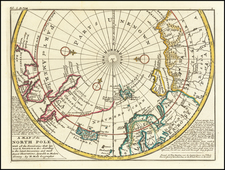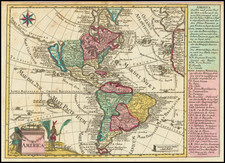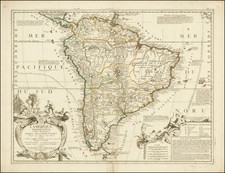The First Printed Map of the Pacific
Striking example of Ortelius' Maris Pacifici . . . , the first printed map of the Pacific Ocean.
Ortelius's Maris Pacifici map was first issued in 1589. It was included in Ortelius influential atlas, Theatrum Orbis Terrarum, in 1590 and it was the earliest map to focus exclusively on the Pacific Ocean. It chronicles the first 75 years of European interaction with the world's largest body of water. The Pacific had first been sighted by a European in 1513, when the conquistador Vasco Nuñez de Balboa looked at its waters from Panama. He named it the Mar del Sur, the South Sea. Less than a decade later, Magellan led an expedition south to try to find a rumored passage to the Spice Islands. When he finally emerged from the straits that would come to bear his name he rejoiced at the calm waters than awaited him, a pacific sea that would become the Pacific after his ship's (but not his) return in 1522. More information about the Pacific trickled back to Europe from Spanish expeditions which, by 1566, had forged a circular trade route from Acapulco to Manila.
Ortelius combined both names for the ocean in the title of the map, "A very new description of the peaceful sea, commonly called South Sea with the regions lying around it, and its islands, scattered everywhere". These islands are not randomly scattered, rather they are meticulously placed based on the information available to Ortelius at the time. The map is based upon Mercator's world map of 1569, with details from 25 Portuguese manuscript maps by Bartolomeo de Lasso which Plancius obtained and later used for his own world map. Ortelius also used travel accounts, including those of the Magellan circumnavigation by Maximilianus Transylvanus (Cologne, 1523) and Antonio Pigafetta (Paris, 1525 and circulated in manuscript with 23 maps). English travel writer Richard Hakluyt also provided Ortelius with place names from recent discoveries in North America, unpublished as yet for political reasons.
On the map, the viewer's eye is immediately drawn to a large ship which dominates the open waters of the Pacific. It is Magellan's Victoria. Tierra del Fuego, first sighted by Magellan, is the tip of a southern land, Terra Australis, Sive Magellancia, Nondum Detecta, which extends westward in an ascending slope toward a large, insular Nova Guinea. New Guinea appears much different than on Ortelius' world map of 1588, suggesting he may have drawn additional information from an unrecorded voyage. Among other notable features, it is detached from Terra Australis. Ortelius thought of the southern continent as nondum, "not yet" detected-a geographic certainty that only awaited further European exploration.
Ortelius shows the Moluccas and the Philippines, an area contested at the time by the Dutch, Spanish, and Portuguese. The Moluccas in particular were a spot of contention between the Iberian kingdoms; the 1529 Treaty of Zaragoza granted the spice-rich islands to Portugal in return for Portuguese capital to finance Charles V's wars against the Protestants and Ottomans in Europe.
Ortelius includes a mis-projected Japan. An odd Isla de Plata appears above Japan. Further south, Guam ( Restiga de Ladrones) is also shown. The reference to thieves, ladrones, in the name resulted from Magellan's perception of the islanders as robbers, but in reality there was a cultural misunderstanding between the Europeans and the islanders about property rights.
The Solomons are located to the east of New Guinea, as are some of the islands of Micronesia. Information about the Solomons would come from the voyage of Álvaro de Mendaña. In November 1567 Mendaña sailed west from Callao. By February 7, 1568, he and his men had arrived at Santa Isabel in the Solomon Islands, labeled as Isabella in Ortelius' map. The islands would be revisited in another expedition led by Mendaña and his wife in 1595, but thereafter the exact location of the islands was muddled, leaving them as wandering islands in subsequent Pacific maps.
In a deviation from his previous maps, including Typus Orbis Terrarum, Ortelius did not include the Strait of Anian skirting North America, the possible entrance to a Northwest Passage, in this map. The treatment of America and most notably the Northwest Coast is reminiscent of Hondius' depiction of America. This map and the Hondius/Le Clerc's map of 1589 (known only in the 1602 edition) have a curious and not fully understood relationship as to which is truly the first map of the Pacific, although because no example of the 1589 Hondius/Le Clerc has been discovered, this map retains primacy.
Maris Pacifici appeared in later editions of Ortelius' Theatrum Orbis Terrarum. Originally published in 1570, it is widely regarded as the first modern atlas. At the time of its publication, it was the most expensive book ever produced. Between 1570 and 1612, it was issued in 31 editions and 7 languages.
The map reflects a much smaller body of water than the true size of the Pacific. The treatment of America and most notably the Northwest Coast is reminiscent of Hondius' America. This map and the Hondius/Le Clerc's rare map of 1589 (known only in the 1602 edition), have a curious and not fully understood relationship as to which is truly the first map of the Pacific, although because no example of the 1589 Hondius Le Clerk has been discovered, this map retains primacy.
Ortelius' The atrum Orbis Terrarum is widely regarded as the first modern atlas. At the time of its publication, it was the most expensive book ever produced. Between 1570 and 1612, it was issued in 31 editions and 7 languages.
T. Suarez (1983) Early Mapping of the Pacific Ocean, The Map Collector 22: pp. 2-9.
Abraham Ortelius is perhaps the best known and most frequently collected of all sixteenth-century mapmakers. Ortelius started his career as a map colorist. In 1547 he entered the Antwerp guild of St Luke as afsetter van Karten. His early career was as a business man, and most of his journeys before 1560, were for commercial purposes. In 1560, while traveling with Gerard Mercator to Trier, Lorraine, and Poitiers, he seems to have been attracted, largely by Mercator’s influence, towards a career as a scientific geographer. From that point forward, he devoted himself to the compilation of his Theatrum Orbis Terrarum (Theatre of the World), which would become the first modern atlas.
In 1564 he completed his “mappemonde", an eight-sheet map of the world. The only extant copy of this great map is in the library of the University of Basel. Ortelius also published a map of Egypt in 1565, a plan of Brittenburg Castle on the coast of the Netherlands, and a map of Asia, prior to 1570.
On May 20, 1570, Ortelius’ Theatrum Orbis Terrarum first appeared in an edition of 70 maps. By the time of his death in 1598, a total of 25 editions were published including editions in Latin, Italian, German, French, and Dutch. Later editions would also be issued in Spanish and English by Ortelius’ successors, Vrients and Plantin, the former adding a number of maps to the atlas, the final edition of which was issued in 1612. Most of the maps in Ortelius' Theatrum were drawn from the works of a number of other mapmakers from around the world; a list of 87 authors is given by Ortelius himself
In 1573, Ortelius published seventeen supplementary maps under the title of Additamentum Theatri Orbis Terrarum. In 1575 he was appointed geographer to the king of Spain, Philip II, on the recommendation of Arias Montanus, who vouched for his orthodoxy (his family, as early as 1535, had fallen under suspicion of Protestantism). In 1578 he laid the basis of a critical treatment of ancient geography with his Synonymia geographica (issued by the Plantin press at Antwerp and republished as Thesaurus geographicus in 1596). In 1584 he issued his Nomenclator Ptolemaicus, a Parergon (a series of maps illustrating ancient history, sacred and secular). Late in life, he also aided Welser in his edition of the Peutinger Table (1598).

![[English Edition!] Maris Pacifici quod vulgo Mar del Zud By Abraham Ortelius](https://storage.googleapis.com/raremaps/img/small/71000.jpg)













